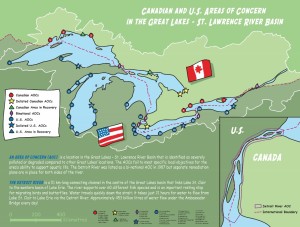Here are some frequently asked questions and answers from the Detroit River Canadian Cleanup:
Q1. What is an area of concern?
An Area of Concern (AOC) is a location where environmental quality is degraded compared to other areas in the Great Lake Basin resulting in the impairment of beneficial uses. A total of 43 AOCs were identified as a result of Annex 2 of the Great Lakes Water Quality Agreement (GLWQA).

Areas of Concern recognized by the Great Lakes Water Quality Agreement
Q2. Is there an Area of Concern in the Windsor/Essex region?
The Detroit River is recognized as an Area of Concern in the Windsor/Essex region as well as the greater Detroit MI geographic area. The Detroit River is recognized as a bi-national Area of Concern.

The Detroit River
Q3. What caused the Detroit River to become an Area of Concern?
When the Windsor-Detroit area underwent rapid industrialization at the turn of the 20th century, the Detroit River became notoriously polluted. Issues facing the Detroit River are combined sewer overflows, urbanization and land use or degradation of habitat and toxic contaminants such as mercury, PCBs, PAHs and metals in the water and sediment. These environmental issues have been identified as being related to, or the cause of, the impairment of several beneficial uses.
Q4. What is the plan to cleanup and restore the Area of Concern?
The identification of the AOCs initiated the Remedial Action Plan (RAP). A RAP is a cleanup plan for restoring the environmental quality of an Area of Concern (AOC) such as the Detroit River. The RAP is administered locally in accordance with the Canada-U.S. Great Lakes Water Quality Agreement (GLWQA) and the Canada-Ontario Agreement (COA). The RAP is an ongoing collaborative effort implemented by federal, provincial, and local governments as well as industry and public partners. The Detroit River Remedial Action Plan and associated publications can be found on this page here.
Q5. Who oversees the Remedial Action Plan for the Detroit River?
T he Detroit River Canadian Cleanup implements the Remedial Action Plan on behalf of a community-based partnership working together to protect, restore and enhance the Detroit River ecosystem. The federal, provincial and municipal government, local industries, scientific researchers, local environmental organizations and many dedicated citizens are key partners and play an important role in the cleanup process. The DRCC’s member organizations provide leadership in identifying partnerships and funding opportunities to support and implement clean up goals.
Q6. What is a beneficial use impairment?
A Beneficial Use Impairment (BUI) is a condition that interferes with the enjoyment of a water use, and can cause any of the following:
- Restrictions on fish and wildlife consumption
- Tainting of fish and wildlife flavour
- Degradation of fish and wildlife populations
- Fish tumours or other deformities
- Bird or animal deformities or reproductive problems
- Degradation of benthos
- Restrictions on dredging activities
- Eutrophication or undesirable algae
- Restrictions on drinking water consumption, or taste and odour problems
- Beach closings
- Degradation of aesthetics
- Added costs to agriculture or industry
- Degradation of phytoplankton and zooplankton populations
- Loss of fish and wildlife habitat
Q7. Which Beneficial Uses are impaired for the Detroit River?
The Detroit River Beneficial Use Impairment statuses can be found here.
Q8. What does it mean to de-list an Area of Concern?
This lengthy process includes the removal of an AOC from the list of Great Lakes Areas of Concern by meeting the criteria for the restoration of beneficial uses as defined by the RAP and agreed upon by the agencies and community.
Q9. What does an Area in Recovery mean?
An area, originally identified as an AOC, where, based on community and government consensus, all scientifically feasible and economically reasonable actions have been implemented and additional time is required for the environment to recover.
Q10. What can I do to contribute positively to the de-listing of the AOC?
- Always dispose solid and liquid hazardous and non-hazardous waste waste properly. It is important to be environmentally responsible and take care of the Detroit River system! Visit Windsor Essex Solid Waste Authority’s website http://www.ewswa.org/ for information regarding waste disposal in Essex region.
- This includes not pouring anything down the storm drain.
- If you see illegal dumping or a spill in and along the water channel, report it using any of the following ways:
- 1-800-265-7672 (area code 519 only)
- Public Information Centre: 1-800-565-4923
- Spills Action Centre: 1-800-268-6060
- Pollution Hotline: 1-866-663-8477
- Avoid water activities such as washing your vehicle in areas where the wastewater will flow into the storm sewer. Washing on a lawn or gravel surface allows wastewater to be absorbed by soil below
- Keep the storm sewers clean and void of litter and debris during heavy rain events. Rainwater is the only liquid that should go down the storm sewers!
- Watch the DRCC video: What happens to our wastewater?
